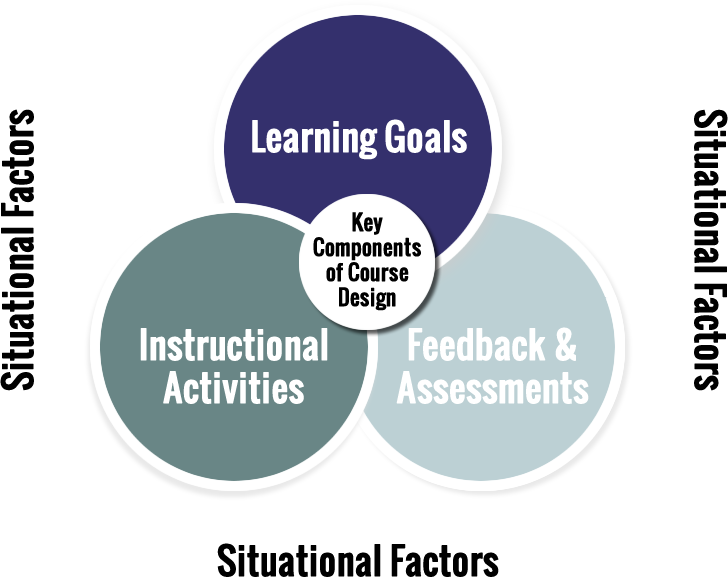Course Design
Effective course design begins and ends with your students in mind. Questions such as “What are you teaching (learning outcomes and objectives)?” and “how will you determine your students learned what you taught and to what degree of mastery (Formative and/or Summative Assessments) guide your instructional strategies and planned learning experiences. Although your course delivery method, class size, and/or subject matter may vary, a systematic approach will help you as you design your instruction.
Instructional Design Models:
Instructional Design has been defined as a process, a science, and a field of study. In the context of course design, instructional design is a systematic planning process for developing learning experiences.
Commonly used instructional design models are:
- ADDIE
- Dick and Carey
- Backwards Design (Wiggins & McTighe)
The Course Design Process
Before you begin the design process, it's helpful to plan it on paper. Here is a downloadable Course Alignment Worksheet that can help you in the planning process.

In the process of building your course let's look at the following steps.
Step 1: Determine your Learning Goals and Objectives.
According to Quality Matters, Learning Objectives in your course need to be measurable, clearly stated and written from your students' perspectives and suitable to the level of the course (QM General Standard 2; 2.1, 2.2, 2.3, 2.4, and2.5).
Writing Learning Objectives:
Learning Objectives answers the question of "What do you want your students to be able to do by the end of the course?" Learning Objectives should clearly state the intended learning outcome of what is expected from them. They are also used as the basis for your assessments.
Taxonomy of Educational Objectives (Bloom's Taxonomy):
Used a framework for categorizing educational goals, Bloom's taxonomy is useful in that it helps the instructor: (1) plan and deliver appropriate instruction, (2) design valid assessment tasks and strategies, and (3) ensure that instruction and assessment are aligned with the objectives.
Anderson, L. W., Krathwohl, D. R., Airasian, P., Cruikshank, K., Mayer, R., Pintrich, P., ... & Wittrock, M. (2001). A taxonomy for learning, teaching and assessing: A revision of Bloom’s taxonomy. New York. Longman Publishing. Artz, AF, & Armour-Thomas, E.(1992). Development of a cognitive-metacognitive framework for protocol analysis of mathematical problem solving in small groups. Cognition and Instruction, 9(2), 137-175.
Step 2: Determine Your Assessments
Your assessments should clearly measure your learning objectives or competencies (Quality Matters General Standard 3). Also, in your syllabus and even your Blackboard course, it's best practice to have your grading policy clearly stated and provide your with multiple opportunities to track their learning progress.
Assessments can be Formative or Summative. Formative Assessments can be seen more like practice assignments, informal polls or short quizzes. Typically Formative Assessments are low stakes, because the overall goal is to assess or monitor student learning and give feedback.
Other Examples of Formative Assessments:
- Submitting a research paper for early feedback
- Concept or web mapping
- A practice quiz
Summative Assessments are used to evaluate student learning at the end of a topic or unit. These high stakes assessments can be in the form of a final paper, or midterm exam.
Other Examples of Summative Assessments:
- A comprehensive Final Exam
- A digital story
- A video
Step 3: Plan and Determine Your Learning Activities & Tools
After you have identified your learning goals and assessments, the next step is to plan and determine your learning activities and experiences. During this time, you it's also a good time to look at available technical tools and resources. As an instructor, this is where you can really be innovative and creative, while keeping in mind what you know about your students.
Contact your Learning Support Specialist or any of the Center for Academic Innovation Staff if you would like assistance or suggestions for learning activities that can be used with or without technology!
Additional Resources:
The Pedagogy Wheel V4.1 Poster: This downloadable poster includes Bloom's taxonomy, sample activities for each domain and applicable apps or technology that you can use to support your activities.

